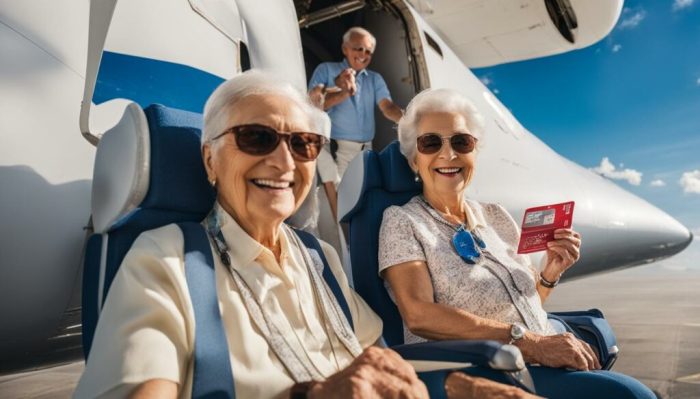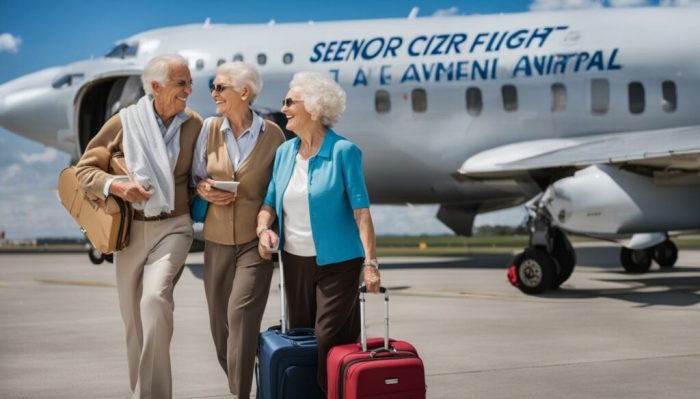Senior Flights represent a significant market segment with unique needs and considerations. This report delves into the intricacies of air travel for older adults, examining everything from booking strategies and in-flight comfort to airport navigation and emergency preparedness. We analyze pricing models, explore accessible travel options, and highlight destinations particularly suited to senior travelers, aiming to provide a comprehensive resource for both individuals and travel professionals.
The aging population’s increasing desire for travel necessitates a deeper understanding of their specific requirements. This goes beyond simply offering discounts; it encompasses ensuring comfortable seating, providing accessible airport assistance, and addressing potential health concerns. This report unpacks these multifaceted elements, offering practical advice and insights to facilitate a smoother, more enjoyable travel experience for senior citizens.
In-Flight Comfort and Amenities

Air travel, while a marvel of modern engineering, can be particularly challenging for senior passengers. Ensuring a comfortable and safe journey for this demographic requires a focused approach to in-flight amenities and services, going beyond the standard offerings. Airlines must prioritize the specific needs of older travelers to foster a positive travel experience and encourage continued air travel among this important segment of the population.
Comfortable Seating for Senior Passengers
Ergonomic seating is paramount for senior travelers, many of whom may experience joint pain, reduced mobility, or other physical limitations. Seats offering ample legroom, adjustable lumbar support, and wider widths are crucial for mitigating discomfort during long flights. The ability to recline fully, without impeding the passenger behind, is also a significant factor in promoting comfort and rest.
Airlines should consider offering premium seating options specifically designed with these needs in mind, possibly at discounted rates for seniors, or through loyalty programs tailored to this demographic. Furthermore, the use of higher-quality cushioning materials that provide better support and pressure relief can greatly enhance the travel experience.
In-Flight Assistance for Seniors with Mobility Issues
Airlines should proactively offer assistance to senior passengers with mobility issues. This assistance should begin before the flight, with clear communication channels and pre-boarding options. Onboard, readily available assistance with boarding, deplaning, and navigating the aircraft is essential. Well-trained cabin crew members should be adept at handling wheelchairs, providing assistance with seatbelts, and attending to other needs.
Clear signage and accessible restrooms are also crucial. The availability of aisle seats or seats near restrooms can significantly reduce the burden on mobility-impaired seniors. Airlines could also explore partnerships with specialized mobility assistance providers to guarantee a seamless and safe journey.
In-Flight Amenities Beneficial for Senior Travelers
Several in-flight amenities cater specifically to the needs of senior travelers. Easily digestible meal options, catering to dietary restrictions and preferences common among older adults (e.g., low-sodium, blander options), are a significant factor in promoting well-being during the flight. Similarly, clear and large-print menus and in-flight entertainment guides are essential for improved accessibility. Entertainment options should include a diverse range of programming, including classic films, documentaries, and audiobooks, appealing to a broader range of tastes found in the senior demographic.
Furthermore, providing noise-canceling headphones can reduce stress and enhance relaxation, which is particularly beneficial for those sensitive to loud noises.
Airlines Offering Superior Comfort for Seniors
Several airlines are taking steps to improve the in-flight experience for seniors. However, a consistent and comprehensive approach across the industry is still needed. Here are some features that differentiate airlines catering to senior needs:
- Wider Seats and Increased Legroom: Airlines offering extra-legroom seating or seats with significantly wider dimensions are preferable.
- Pre-boarding Assistance: Airlines that provide dedicated pre-boarding for seniors and those with mobility challenges.
- Specialized Meal Options: Airlines that offer a variety of healthy and easily digestible meal options tailored to senior dietary needs.
- Accessible In-Flight Entertainment: Airlines with large-print menus and a wide selection of entertainment options catering to older travelers’ preferences.
- Dedicated Onboard Assistance: Airlines with well-trained staff specifically tasked with assisting senior passengers with mobility issues.
Airport Navigation and Assistance: Senior Flights

Navigating airports can present unique challenges for senior travelers, but numerous services and technologies are designed to ease the journey. Understanding these resources and planning ahead can significantly improve the overall travel experience, minimizing stress and maximizing comfort. This section details the support available and offers a practical guide for efficient airport transit.Airport services for senior travelers encompass a range of assistance programs, designed to address the specific needs of older adults.
These programs often include wheelchair assistance, expedited security screening, and assistance with baggage handling. Many larger airports also offer dedicated lounges with comfortable seating and amenities tailored to the needs of senior citizens. Furthermore, airport staff are generally trained to provide assistance to those who require it, whether it’s finding gates or navigating complex airport layouts.
Airport Assistance Programs
Several programs are specifically designed to support senior travelers’ needs throughout the airport journey. These often involve pre-booked assistance for wheelchair users, individuals with mobility limitations, or those requiring additional support. Some airlines offer dedicated assistance programs, while others partner with third-party providers specializing in airport assistance. These services typically include wheelchair transport from curbside to gate, assistance with baggage claim, and escort services to help navigate the airport.
Contacting your airline or the airport directly well in advance of your travel date is recommended to secure these services.
Efficient Airport Navigation for Seniors
Efficient airport navigation for seniors relies heavily on careful planning and utilizing available resources. Pre-booking assistance services, as mentioned previously, is a crucial first step. Studying the airport map online beforehand helps familiarize oneself with the terminal layout, gate locations, and the proximity of amenities like restrooms and seating areas. Allowing ample time to navigate the airport is essential, accounting for potential delays and the need for frequent rest stops.
Prioritizing direct routes and avoiding unnecessary backtracking minimizes physical exertion.
Assistive Technologies in Airports, Senior Flights
Many airports are increasingly incorporating assistive technologies to enhance accessibility for senior travelers. These include wayfinding apps with real-time information on gate locations, estimated walking times, and accessible restroom locations. Interactive kiosks offering airport information and assistance in multiple languages are becoming more commonplace. Furthermore, airports often provide visual aids, such as clear signage with large fonts and high contrast colors, making navigation easier for those with visual impairments.
Some airports also feature audio announcements and tactile paving to guide travelers with visual or auditory challenges. For example, Heathrow Airport in London employs a sophisticated system of wayfinding apps and digital signage integrated with passenger information systems.
Step-by-Step Guide for Senior Airport Navigation
- Pre-book assistance services (wheelchair, baggage handling, etc.) with your airline or the airport well in advance.
- Familiarize yourself with the airport map online and plan your route, identifying key locations like security checkpoints, gates, and restrooms.
- Arrive at the airport with ample time to spare, accounting for potential delays and the need for frequent breaks.
- Utilize available assistive technologies, such as wayfinding apps and interactive kiosks, to aid navigation.
- Seek assistance from airport staff if needed; they are generally trained to help travelers.
- Take frequent breaks to rest and avoid overexertion.
- Stay hydrated and ensure you have any necessary medications readily available.
- Allow extra time for security checks and baggage claim.
- Confirm your gate number frequently, as it may change.
- Communicate your needs clearly to airport staff and airline personnel.
Navigating air travel as a senior citizen requires careful planning and awareness of available resources. From understanding airline pricing structures and securing suitable travel insurance to utilizing airport assistance and selecting senior-friendly destinations, proactive preparation is key. This report has provided a framework for optimizing the travel experience for older adults, emphasizing the importance of comfort, accessibility, and peace of mind.
Ultimately, the goal is to ensure that the joy of travel remains accessible to all, regardless of age.

